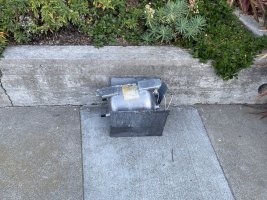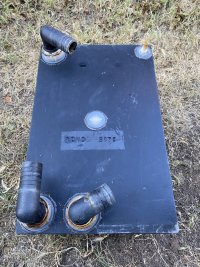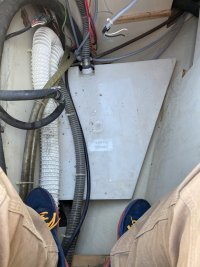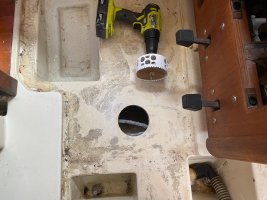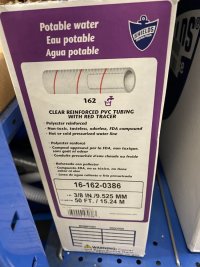Hi All,
I am looking for help diagnosing an issue with my freshwater (potable) water pump.
The pump is a ShurFlo and I believe the manufacture date is 1998. When I bought my boat, the pump would come on and then cycle a handful of times after use, but eventually turn itself off (while remaining powered on). Gradually the cycling became worse.
Symptom 1: Pump runs continuously
The pump will not turn off now, even with the water faucet off, and all of the manifold valves closed.
Symptom 2: Water flowing to bilge from stern.
While the pump is on, wate flows into the bilge from the stern of the boat. My boat has two tanks aft of the bilge where I see water appearing - my hot water tank and a freshwater tank beneath my starboard cockpit locker.
Fix attempt 1: Removed the pump, cleaned some junk from a pre-pump screen filter on the output side.
Fix attempt 2: After reading about problems with the check valve, I disassembled the pump, removed the diaphragm at the bottom, cleaned it and reassembled. The pump moves water like a champ when the faucet is open and it is drawing water from a full tank.
Fix attempt 3. Disassembled the hot water tank. An audible gasp of a vacuum being opened occurred when I unscrewed the freshwater connectors from the hot water tank. It does not seem like this tank is leaking.
Fix attemp 4: Access and inspect the freshwater tank at the stern. I have not done this step and it will involve removing my blackwater tank (oooh gross) which is why I am writing this forum thread to make sure I am not missing something obvious.
What I don't understand is how I can keep pushing freshwater into my bilge if all of the valves on the manifold are closed. (That is what happens). Is this a sign of the check valve in the pump being bad? If am not serving any water to the input side of the pump, it seems like I must be forcing pressure into the post-pump side of the plumbing and I have a leak somewhere.
Any ideas, oh ye wise and clever fellow boat owners?
I already had one broken Ronco freshwater tank I replaced. I am confident no one has removed the starboard aft freshwater tank during the life of the boat (I was pulling factory bung plugs during my assessment.
I am looking for help diagnosing an issue with my freshwater (potable) water pump.
The pump is a ShurFlo and I believe the manufacture date is 1998. When I bought my boat, the pump would come on and then cycle a handful of times after use, but eventually turn itself off (while remaining powered on). Gradually the cycling became worse.
Symptom 1: Pump runs continuously
The pump will not turn off now, even with the water faucet off, and all of the manifold valves closed.
Symptom 2: Water flowing to bilge from stern.
While the pump is on, wate flows into the bilge from the stern of the boat. My boat has two tanks aft of the bilge where I see water appearing - my hot water tank and a freshwater tank beneath my starboard cockpit locker.
Fix attempt 1: Removed the pump, cleaned some junk from a pre-pump screen filter on the output side.
Fix attempt 2: After reading about problems with the check valve, I disassembled the pump, removed the diaphragm at the bottom, cleaned it and reassembled. The pump moves water like a champ when the faucet is open and it is drawing water from a full tank.
Fix attempt 3. Disassembled the hot water tank. An audible gasp of a vacuum being opened occurred when I unscrewed the freshwater connectors from the hot water tank. It does not seem like this tank is leaking.
Fix attemp 4: Access and inspect the freshwater tank at the stern. I have not done this step and it will involve removing my blackwater tank (oooh gross) which is why I am writing this forum thread to make sure I am not missing something obvious.
What I don't understand is how I can keep pushing freshwater into my bilge if all of the valves on the manifold are closed. (That is what happens). Is this a sign of the check valve in the pump being bad? If am not serving any water to the input side of the pump, it seems like I must be forcing pressure into the post-pump side of the plumbing and I have a leak somewhere.
Any ideas, oh ye wise and clever fellow boat owners?
I already had one broken Ronco freshwater tank I replaced. I am confident no one has removed the starboard aft freshwater tank during the life of the boat (I was pulling factory bung plugs during my assessment.

